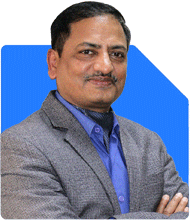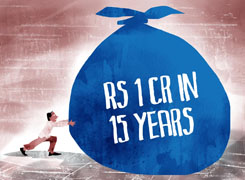Ramalingam Kalirajan |10874 Answers |Ask -Follow
Mutual Funds, Financial Planning Expert - Answered on Apr 01, 2024
He has an MBA in finance from the University of Madras and is a certified financial planner.
He is the director and chief financial planner at Holistic Investment, a Chennai-based firm that offers financial planning and wealth management advice.... more

I m 44 years. Net salary 96K per month. Considering inflation . How much money should I invest..pls suggest different options MF is one of them, to get at least Rs. 1.25L per month income post retirement ?
1. **Calculate Retirement Corpus**: Determine the retirement corpus required to generate a monthly income of Rs. 1.25 lakhs. This will depend on various factors such as your expected lifespan, inflation rate, and expected rate of return on investments during retirement.
2. **Estimate Monthly Investment**: Based on your current age, desired retirement age, and expected rate of return on investments, calculate the monthly investment required to accumulate the retirement corpus. You can use online retirement calculators or consult with a financial advisor to determine this amount.
3. **Diversified Investment Portfolio**: Build a diversified investment portfolio that aligns with your risk tolerance and investment objectives. Consider allocating your investments across different asset classes such as equities, mutual funds, fixed deposits, real estate, and other suitable investment options.
4. **Systematic Investment Plan (SIP)**: Start a SIP in mutual funds that offer the potential for long-term growth while managing risk. Choose funds that invest in a mix of equity and debt instruments to balance risk and return. Regularly review and adjust your SIP contributions based on changes in your financial situation and investment goals.
5. **Tax Planning**: Optimize your tax planning to maximize your savings and investment returns. Utilize tax-saving investment options such as Equity Linked Savings Schemes (ELSS), Public Provident Fund (PPF), National Pension System (NPS), and tax-saving fixed deposits to reduce your tax liability and increase your investible surplus.
6. **Regular Review and Adjustments**: Periodically review your investment portfolio and make necessary adjustments to ensure that you're on track to achieve your retirement income goal. Consider factors such as changes in income, expenses, market conditions, and life events when revising your investment strategy.
7. **Consider Professional Advice**: If you're unsure about the optimal investment strategy to achieve your retirement income target, consider seeking guidance from a qualified financial advisor. An advisor can help assess your financial situation, recommend suitable investment options, and develop a customized retirement plan tailored to your needs and objectives.
Remember that achieving a post-retirement income of Rs. 1.25 lakhs per month requires diligent planning, disciplined savings, and prudent investment decisions. Start early, stay focused on your goals, and regularly monitor your progress to ensure a financially secure retirement.
Best regards.
You may like to see similar questions and answers below
Sunil Lala | Answer |Ask -Follow
Financial Planner - Answered on Oct 13, 2023
Ramalingam Kalirajan |10874 Answers |Ask -Follow
Mutual Funds, Financial Planning Expert - Answered on Apr 23, 2024
Sanjeev Govila | Answer |Ask -Follow
Financial Planner - Answered on Jan 22, 2024
Ramalingam Kalirajan |10874 Answers |Ask -Follow
Mutual Funds, Financial Planning Expert - Answered on May 15, 2024
Ramalingam Kalirajan |10874 Answers |Ask -Follow
Mutual Funds, Financial Planning Expert - Answered on Aug 13, 2024
Mayank Chandel |2569 Answers |Ask -Follow
IIT-JEE, NEET-UG, SAT, CLAT, CA, CS Exam Expert - Answered on Dec 08, 2025
Mayank Chandel |2569 Answers |Ask -Follow
IIT-JEE, NEET-UG, SAT, CLAT, CA, CS Exam Expert - Answered on Dec 08, 2025

Mayank Chandel |2569 Answers |Ask -Follow
IIT-JEE, NEET-UG, SAT, CLAT, CA, CS Exam Expert - Answered on Dec 08, 2025
Mayank Chandel |2569 Answers |Ask -Follow
IIT-JEE, NEET-UG, SAT, CLAT, CA, CS Exam Expert - Answered on Dec 08, 2025
Mayank Chandel |2569 Answers |Ask -Follow
IIT-JEE, NEET-UG, SAT, CLAT, CA, CS Exam Expert - Answered on Dec 08, 2025
Anu Krishna |1746 Answers |Ask -Follow
Relationships Expert, Mind Coach - Answered on Dec 08, 2025
Ramalingam Kalirajan |10874 Answers |Ask -Follow
Mutual Funds, Financial Planning Expert - Answered on Dec 08, 2025
Samraat Jadhav |2499 Answers |Ask -Follow
Stock Market Expert - Answered on Dec 08, 2025
Ramalingam Kalirajan |10874 Answers |Ask -Follow
Mutual Funds, Financial Planning Expert - Answered on Dec 08, 2025
Radheshyam Zanwar |6737 Answers |Ask -Follow
MHT-CET, IIT-JEE, NEET-UG Expert - Answered on Dec 08, 2025


























